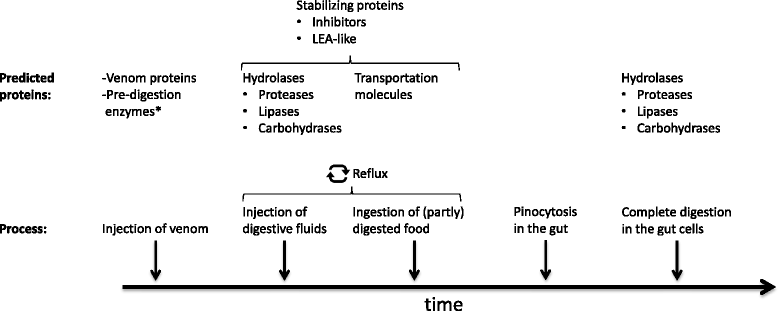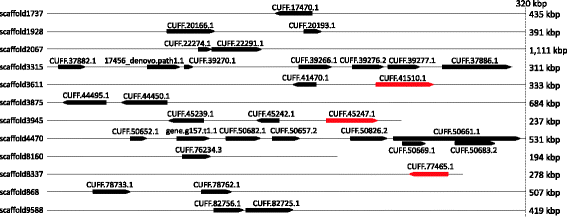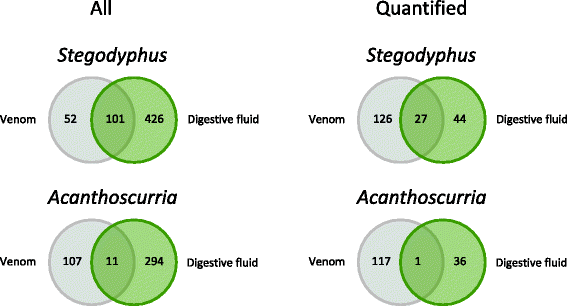Characterisation of protein families in spider digestive fluids and their role in extra-oral digestion
- PMID: 28797246
- PMCID: PMC5553785
- DOI: 10.1186/s12864-017-3987-9
Characterisation of protein families in spider digestive fluids and their role in extra-oral digestion
Abstract
Background: Spiders are predaceous arthropods that are capable of subduing and consuming relatively large prey items compared to their own body size. For this purpose, spiders have evolved potent venoms to immobilise prey and digestive fluids that break down nutrients inside the prey's body by means of extra-oral digestion (EOD). Both secretions contain an array of active proteins, and an overlap of some components has been anecdotally reported, but not quantified. We systematically investigated the extent of such protein overlap. As venom injection and EOD succeed each other, we further infer functional explanations, and, by comparing two spider species belonging to different clades, assess its adaptive significance for spider EOD in general.
Results: We describe the protein composition of the digestive fluids of the mygalomorph Acanthoscurria geniculata and the araneomorph Stegodyphus mimosarum, in comparison with previously published data on a third spider species. We found a number of similar hydrolases being highly abundant in all three species. Among them, members of the family of astacin-like metalloproteases were particularly abundant. While the importance of these proteases in spider venom and digestive fluid was previously noted, we now highlight their widespread use across different spider taxa. Finally, we found species specific differences in the protein overlap between venom and digestive fluid, with the difference being significantly greater in S. mimosarum compared to A. geniculata.
Conclusions: The injection of venom precedes the injection with digestive fluid, and the overlap of proteins between venom and digestive fluid suggests an early involvement in EOD. Species specific differences in the overlap may reflect differences in ecology between our two study species. The protein composition of the digestive fluid of all the three species we compared is highly similar, suggesting that the cocktail of enzymes is highly conserved and adapted to spider EOD.
Keywords: Acanthoscurria; Astacin metalloproteases; Digestive fluid; Extra-oral digestion; Proteomics; Spider; Stegodyphus; Venom.
Conflict of interest statement
Ethics approval and consent to participate
Not applicable.
Consent for publication
Not applicable.
Competing interests
The authors declare that there is no financial and no-financial competing interests.
Publisher’s Note
Springer Nature remains neutral with regard to jurisdictional claims in published maps and institutional affiliations.
Figures





Similar articles
-
Digestive enzymes and sphingomyelinase D in spiders without venom (Uloboridae).Sci Rep. 2023 Feb 15;13(1):2661. doi: 10.1038/s41598-023-29828-x. Sci Rep. 2023. PMID: 36792649 Free PMC article.
-
High throughput techniques to reveal the molecular physiology and evolution of digestion in spiders.BMC Genomics. 2016 Sep 7;17(1):716. doi: 10.1186/s12864-016-3048-9. BMC Genomics. 2016. PMID: 27604083 Free PMC article.
-
Astacin-like metalloproteases are a gene family of toxins present in the venom of different species of the brown spider (genus Loxosceles).Biochimie. 2010 Jan;92(1):21-32. doi: 10.1016/j.biochi.2009.10.003. Epub 2009 Oct 30. Biochimie. 2010. PMID: 19879318
-
Recent advances in the understanding of brown spider venoms: From the biology of spiders to the molecular mechanisms of toxins.Toxicon. 2014 Jun;83:91-120. doi: 10.1016/j.toxicon.2014.02.023. Epub 2014 Mar 11. Toxicon. 2014. PMID: 24631373 Review.
-
The biology and evolution of spider venoms.Biol Rev Camb Philos Soc. 2022 Feb;97(1):163-178. doi: 10.1111/brv.12793. Epub 2021 Aug 28. Biol Rev Camb Philos Soc. 2022. PMID: 34453398 Review.
Cited by
-
Spiders' digestive system as a source of trypsin inhibitors: functional activity of a member of atracotoxin structural family.Sci Rep. 2023 Feb 10;13(1):2389. doi: 10.1038/s41598-023-29576-y. Sci Rep. 2023. PMID: 36765114 Free PMC article.
-
An overview of Phoneutria nigriventer spider venom using combined transcriptomic and proteomic approaches.PLoS One. 2018 Aug 1;13(8):e0200628. doi: 10.1371/journal.pone.0200628. eCollection 2018. PLoS One. 2018. PMID: 30067761 Free PMC article.
-
Temperature dependency of predation: Increased killing rates and prey mass consumption by predators with warming.Ecol Evol. 2020 Aug 21;10(18):9696-9706. doi: 10.1002/ece3.6581. eCollection 2020 Sep. Ecol Evol. 2020. PMID: 33005340 Free PMC article.
-
Venomics of the ectoparasitoid wasp Bracon nigricans.BMC Genomics. 2020 Jan 10;21(1):34. doi: 10.1186/s12864-019-6396-4. BMC Genomics. 2020. PMID: 31924169 Free PMC article.
-
Spider-Venom Peptides: Structure, Bioactivity, Strategy, and Research Applications.Molecules. 2023 Dec 20;29(1):35. doi: 10.3390/molecules29010035. Molecules. 2023. PMID: 38202621 Free PMC article. Review.
References
-
- Cohen AC. Extra-oral digestion in predaceous terrestrial Arthropoda. Annu Rev Entomol. 1995;40:85–103. doi: 10.1146/annurev.en.40.010195.000505. - DOI
-
- Gopalakrishnakone P, Corzo G, de Lima ME, Diego-García E. Spider venoms. Springer Netherlands 2016.
Publication types
MeSH terms
Substances
LinkOut - more resources
Full Text Sources
Other Literature Sources
Research Materials

